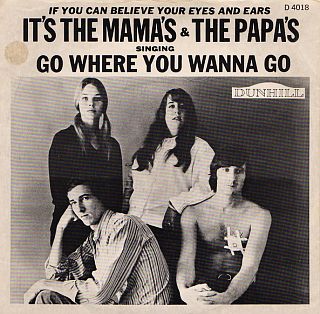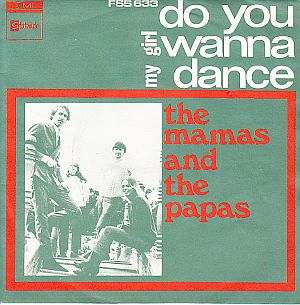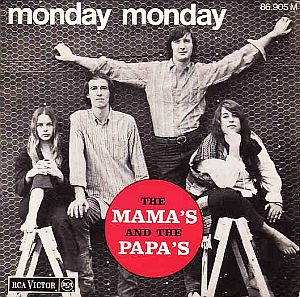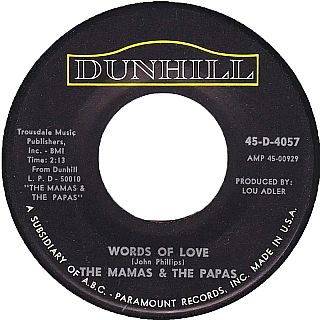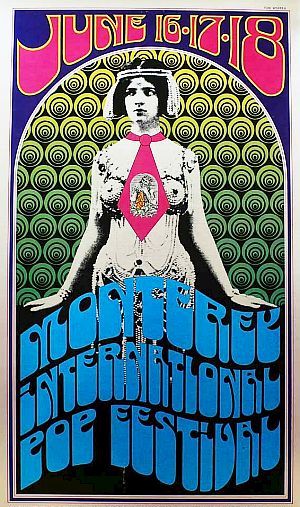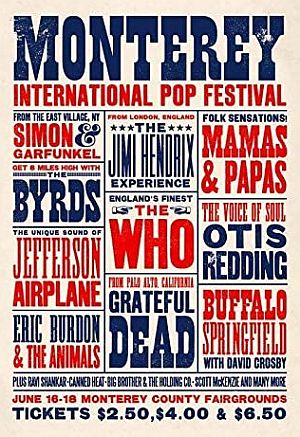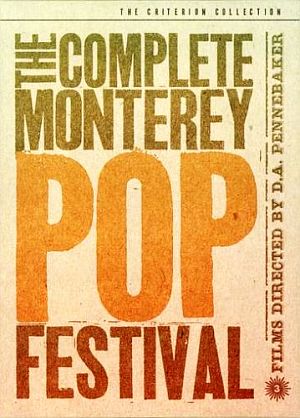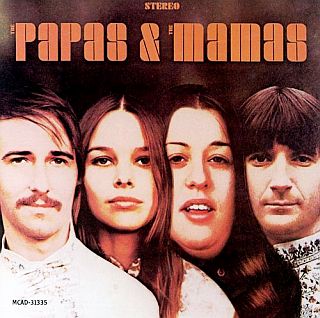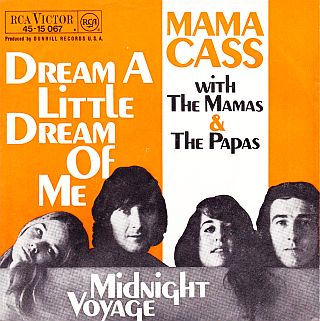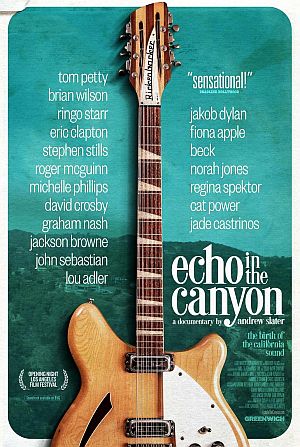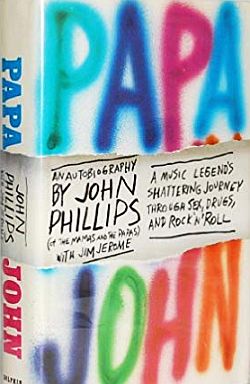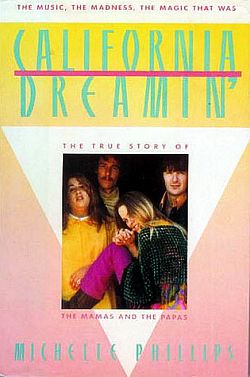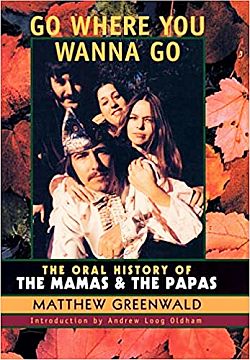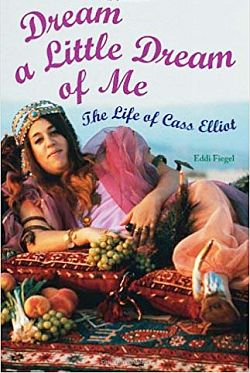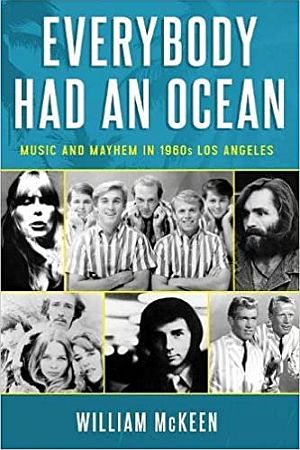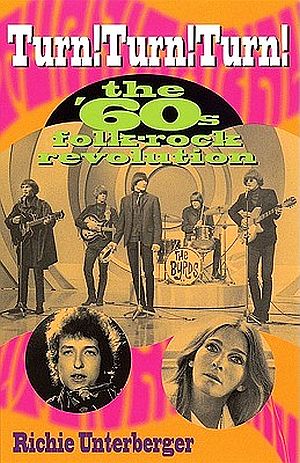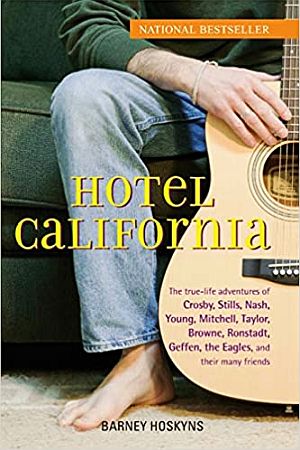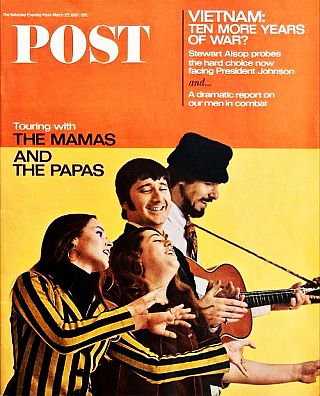
March 1967. The Mamas & The Papas on the cover of “The Saturday Evening Post” magazine after a phenomenal 1966 with chart-topping hits. From left: Michelle Phillips, Cass Elliot, Denny Doherty, and founder/leader, John Phillips. Click for copy.
Music Player
“California Dreamin`”-1965
As the New York Times would note some years later: “…The Mamas and the Papas became one of the most popular and influential American bands of the era between the Beatles’ arrival and Woodstock [roughly between 1965 and 1969]. Their enduring hits, like “California Dreamin’,” “Monday, Monday” and “Dedicated to the One I Love,” mixed the gentle jangle of folk with a rock backbeat and sweet, layered pop vocals.”
The foursome of Denny Doherty, Cass Elliott, John and Michelle Phillips offered an exceptional vocal blend. When they arranged their voices just right, this group could create something their leader, John Phillips, and others would describe as “the fifth voice” — a “two-plus-two-equals-five” kind of thing; a special vocal sound that no one voice could make alone, but together would soar. Their sound, though modern, was not unlike that of a madrigal or choral quality. It was soothing and upbeat, even if some of the lyrics weren’t always so cheery. Their music, on the whole, had broad appeal, for the young and old. It was feel-good and non-threatening, and it sold like wildfire.
But alas, this talented foursome was undone by the soap opera that was their entangled lives, which was also, in part, the wellspring and muse of their success. But for a brief time, they became folk rock’s dominant and leading troubadours, topping the music charts of their day and helping set a certain cultural tone.
The Mamas and Papas left a distinct mark on popular music of the mid-1960s and became part of the Los Angeles/ Laurel Canyon music scene, along with the Beach Boys, The Byrds, Buffalo Springfield, and others then on the leading edge of folk-rock innovation.
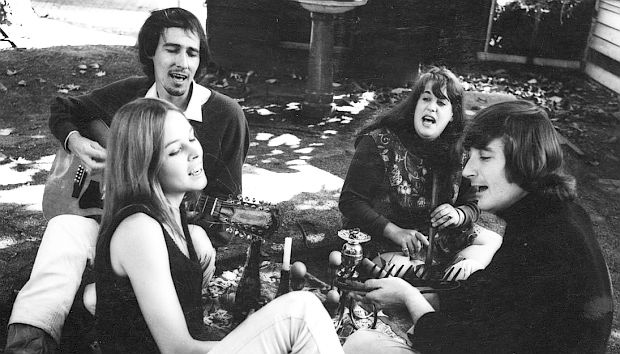
Mamas & Papas making impromptu music at an outing in the Laurel Canyon area near Los Angeles. Mama Cass had a home there for a time, which served as a sometimes gathering spot for area musicians. Photo, Guy Webster.
The Mamas and Papas had an intense few years of musical success and national notice – although much too fleeting given their considerable talents. Were it not for their internal strife, mostly affairs and interpersonal difficulties, plus a later-found disenchantment with the music industry, they might well have had several more years of noteworthy music. Yet for a time, their exceptional sound graced the airwaves.
As it was, in four short years — and mostly in two-and-a-half years — the Mamas and the Papas released five studio albums and 17 singles, six of which made the Billboard top ten. They have sold close to 40 million records worldwide. They were inducted into the Rock and Roll Hall of Fame in 1998. What follows here is a look back at some of their music and group history.

From top: Denny Doherty, John & Michelle Phillips, and Cass Elliot.
Origins
The group had its origin in acoustic folk music. John Phillips, group founder, had learned his craft in the late 1950s in New York’s Greenwich Village’s music scene. He’d also worked with doo-wop and harmony groups and had studied the music of the Four Lads, Four Freshmen, Kingston Trio and others. John was briefly at the Naval Academy then attended Hampden–Sydney College, before dropping out. Later in New York, Phillips and two others, Scott Mackenzie and Dick Weissman, formed the folk group, The Journeyman, producing three albums and some success.
In May 1957, Phillips married Susan Adams of a wealthy Virginia family and the couple had a son, Jeffrey, and a daughter, Mackenzie. In 1961, while touring California with The Journeymen, Phillips met 17 year-old model Holly Michelle Gilliam, with whom he had an affair, followed later by the dissolution of his first marriage. He then married Michelle on December 31, 1962. Michelle Phillips, though not schooled in music, later joined John in a second Journeymen group – the New Journeymen – learning her craft on the job. They first lived in California, and then New York city.
Canadian folk singer Denny Doherty had played with future Lovin’ Spoonful member Zal Yanovsky in the “Halifax Three” Canadian group. He later joined Cass Elliot in a group that became the Mugwumps. Doherty then hooked up with John and Michelle in the New Journeymen. Cass Elliot, meanwhile, worked briefly with a jazz trio before joining Doherty, John and Michelle in the group that would later become the Mamas and the Papas. John, however, was not totally comfortable with their move away from acoustic folk to a more electric-based folk rock, then being influenced by the breakout success of the Beatles and Bob Dylan “going electric” at one celebrated outing. Denny and Cass eventually convinced him to make the change.
“The first time we all sang together,” Michelle Phillips would later recall, “was probably January 9th, 1965, at our apartment in the West Village.” As the folk scene was fading in New York City, Michelle, John and Denny then decamped to the Virgin Islands, in part for a change of scenery and R & R, and in part to try out more rock-based music. Cass, not then a full partner in the musical group, would come later, also working part-time at a Virgin Islands bar named Duffy’s where the others were testing their music. They hadn’t yet congealed as a full group, and it wasn’t clear that Cass would be invited to join, as John was resisting.
After the Virgin Islands, Denny, John and Michelle returned to New York City — but only by the good fortune of John wagering their last dollars at a casino where Michelle’s hot hand won 17 straight passes at the craps table, earning enough for their return air fare. Cass, meanwhile, had gone to Los Angeles. Later that fall, John, Michelle and Denny departed New York by car headed for Los Angeles determined to peddle John’s songs, “California Dreamin’,” “Monday Monday,” and others. Initially, there were no takers. Cass was already in L.A. at the home of either former Mugwumps bandmate James Hendricks or Barry McGuire, when the others joined her there. And it was at some rehearsals at that house, with Cass now fully participating, that the foursome first realized their special sound. “All of a sudden, we’re at her place and this sound happens; this Mamas and Papas sound,” Denny Doherty would later recount. “Even John couldn’t deny it. He started tinkering, saying, ‘Hey, if Cass sings here, Michie, you try singing there, and Denny you move up there.’ That’s how it happened.”
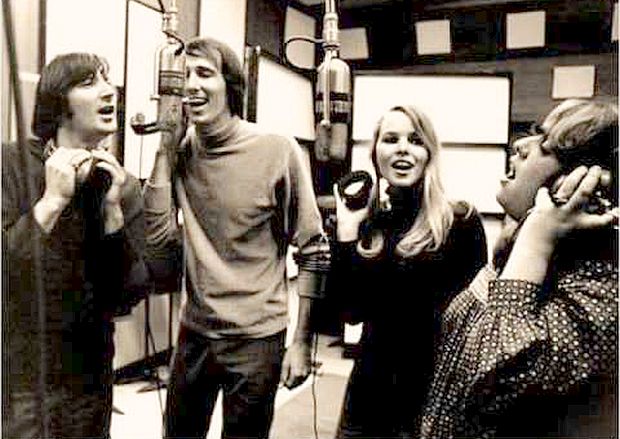
Mamas & Papas at mid-1960s recording session at L.A.'s Western Recording studios on Sunset strip: Denny Doherty, John Phillips, Michelle Phillips, and Cass Elliot.
In California, singer Barry McGuire, who then had the hit song “Eve of Destruction.” (No. 1, September 1965), had known John Phillips and Cass Elliott separately from the folk circuit. McGuire introduced John Phillips to producer Lou Adler, head of Dunhill Records, who agreed to audition the group. At the audition, Adler kept a poker face as he listened to them perform a series of songs, repeatedly asking “what else ‘ya got?” But Adler was actually floored by what he heard. “I couldn’t believe anything that good had just walked in off the street,” he would say in a later 1966 Life magazine story.
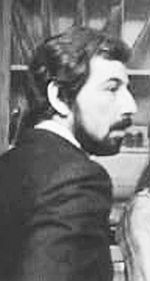
Lou Adler, mid-1960s.
In terms of the group’s composition, John still had doubts about, and some differences with, Cass Elliott formally joining the group, but was outvoted by Denny, Michelle and Dunhill’s Lou Adler. Cass, in fact, with her powerful contralto, had the strongest voice of the four. Denny Doherty added a very pure tenor. And Michelle offered a clear and bright soprano. John was group leader and chief songwriter, described as “a genius at arranging harmony.” But it was the particular mixing of their male and female voices that became their distinctive trademark, plus excellent arrangements and instrumental backing by L.A,’s famed session musicians, “the wrecking crew.”
California Dreamin`

45 rpm vinyl single of “California Dreamin,” released, Dec 1965, rising to No.4, March 1966. Click for digital,
It was written in its first stages by John Phillips, who wrote and arranged most of the group’s songs. He first worked on “California Dreamin`” in 1963 when he and Michelle were living in New York City during a particularly cold winter. Michelle was sorely missing sunny California, at the time.
John often worked on his music late at night, and one morning after writing the first verse or so, he woke Michelle to play what he had and work on further lyrics. Michelle wasn’t excited about being roused from her sleep, and wanted to work on it the next morning. But John insisted, asking her to write down the first verse, and to help craft more lyrics.
“Trust me,” he said, “you’ll thank me for this later. Write this down.” Michelle then proceeded to add some lyrics from when she and John had walked in a New York city snow and had “stopped in a church.” Michelle, in fact, would become the co-author of that song, giving her half the publishing and half the writer’s fees — which for that song would become quite a windfall for years and years. She would later say of John’s rousing her that night it was the best wake-up call she ever had.
Although a cover version of “California Dreamin`” had been recorded for a Barry MaGuire album as a “thank you” for his introduction to Lou Adler, that version did not take off. The Mamas and Papas’ “California Dreamin`” was released as a single on December 18th, 1965, touted by a full-page ad in Billboard magazine. In the song, John’s guitar backs the soprano voice of Michelle, Denny Doherty provides the lead tenor, and Cass Elliott adds her powerful contralto to the vocal blend that propels the song. Session musicians P.F. Sloan contributed the guitar introduction and Bud Shank the alto flute solo.

1966. “If You Can Believe Your Eyes and Ears,” debut album of Feb 1966, with “California Dreamin`” single released ahead of album, Dec 1965. Click for CD or singles.
There was also plenty of competition on the music charts at the time “California Dreamin’” was released. In late December 1965, The Byrds were riding high with their No. 1 folk-rock blockbuster, “Turn! Turn! Turn!” Simon & Garfunkel also had a Top Ten song, “The Sounds of Silence.” The Beatles, The Lovin` Spoonful, The Supremes, The Righteous Brothers, James Brown, and the Four Seasons also had hits in the Top 10 or 20 at that time.
“California Dreamin'” made its chart debut on the Billboard Hot 100 in January 1966. It then peaked on that chart at No. 4 in March 1966, remaining there for 17 weeks, and also on the Cashbox chart for 20 weeks.
“California Dreamin`” hit No. 1 on some individual radio surveys – such as New York City’s WABC survey, where it held at No.1 for four weeks during March and April 1966. By June 1966 it was certified Gold by the Recording Industry Association of America. It was also listed in year-end surveys among the top songs of 1966.
“California Dreamin'” also hit No. 23 in the UK. In 1997, it charted again in the UK after it was used in a Carling Premier beer ad, then peaking at No. 9. In 2001, “California Dreamin'” was inducted into the Grammy Hall of Fame, and in 2007 Rolling Stone magazine ranked it No. 89 in its list of the 500 Greatest Songs of All Time. According to one count, by early 2020, “California Dreamin’,” had been streamed nearly 240 million times on Spotify.
|
Mamas & Papas Side One Side Two |
Superb Album
The group’s debut album, If You Can Believe Your Eyes and Ears, included “California Dreamin’,” but its release came after the single. By February 1966, it hit No. 1 on the Billboard albums chart. In addition to “California Dreamin,” the album was full of good songs, not least of which was their follow-up single to “California Dreamin`” and their first No. 1 hit, “Monday, Monday.” More on that song a bit later.
However, there are at least six other songs on that first album that did not initially get specific chart recognition in 1966, but also delivered stellar vocals and solid performances, including: “Straight Shooter,” “Got a Feelin’,” “Go Where You Wanna Go,” and covers of three other songs: the Beatles’ tune, “I Call Your Name,” with Mama Cass Elliott in the lead; Bobby Freeman’s “Do You Wanna Dance;” and “Spanish Harlem,” written by Jerry Leiber and Phil Spector.
All of these Mamas and Papas songs have an airy, folky, breezy California feel to them, and seemed musically innocent. Yet the subject matter behind some of them was actually documenting the internal strife, jealousies, and love affairs that would contribute to the group’s demise – though generally not apparent to the listening public. It would be this autobiographical angst of the group that would fuel a number of their songs.
Free-spirited Michelle seemed to be at the center much of the turmoil, as she had affairs early on with others, including bandmate Denny Doherty, which soon had both John and Denny writing song lyrics about her. At least three of the songs on the first album – “Straight Shooter,” “Got A Feelin,” and “Go Where You Wanna Go” – appear to have Michelle as their muse, at least in part.
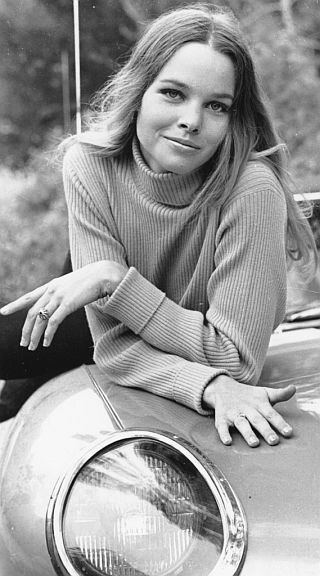 Michelle Phillips; devilish pose and “Mona Lisa” smile. |
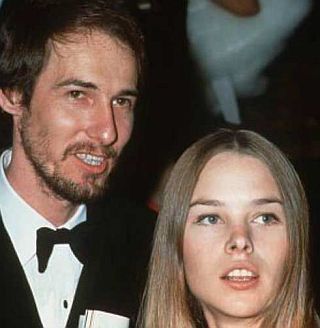 John Phillips and his youthful wife, Michelle Phillips, mid-1960s. |
“Straight Shooter” is a John Philllips song with verse and message directed at Michelle:
Music Player
“Straight Shooter”-1965-66
[sample verse]
Don’t get me mad, don’t tell no lie
Don’t make me sad, don’t pass me by
Baby are you holding,
holding anything but me?
Because I’m a real straight shooter
If you know what I mean
You can bring me love,
you can hang around
You can bring me up,
don’t you bring me down
Baby are you holding,
holding anything but me?
Because I’m a real straight shooter
If you know what I mean…
Music Player
“Got a Feelin`”-1965-66
“Got A Feelin,” by both John and Denny, is possibly suggesting that they’re both being played by the winsome beauty?
 John & Michelle Phillips in what appears to be a dressing room prior to performance, mid-1960s. |
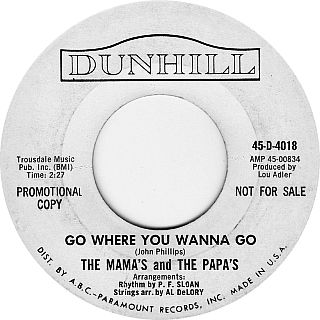 Dunhill promotional 45rpm record for "Go Where You Wanna Go". |
[sample verse]
Got a feelin’ that I’m wasting time
on you babe
Got a feelin’ that you’ve been untrue
I got a feelin’ that you’re stealin’
All the love I thought I was giving to you
Baby, it’s true. the joke’s on you…
Michelle Rising
Michelle had been raised by her father after her mother died when she was five years old. Her father was quite liberal and they also moved around a bit. In 1951 he took Michelle and her sister to live in Mexico City where they went to school and became fluent in Spanish before returning to Los Angeles. In L.A., at about age 13, Michelle met Tamar Hodel, a 23 year-old married women, reported as something of a beauty herself and a Kim Novak look-alike. (Tamar was the daughter of the infamous George Hodel, murder suspect in the Black Dahlia case [Elizabeth Short, 1947], also accused of raping Tamar, though neither case was proved.) Michelle became quite enamored of Tamar.
When Tamar first saw Michelle – whom she described as “a gorgeous little Brigitte Bardot” – she wanted to champion her “because no one had championed me” (Tamar having had a difficult raising). Michelle then needed a female model. And so began a tutelage of sorts in the social survival skills, as Michelle and Tamar became fast friends. Vanity Fair’s Sheila Weller notes: “Tamar took the lower-middle-class bohemian’s daughter and polished her. She bought her clothes…, enrolled her in modeling school, taught her how to drive…”
By early-1961, after Tamar divorced her husband, she and Michelle moved to San Francisco, where they enjoyed the club scene, including folk bands. Tamar briefly took up with one musician named Scott McKenzie, who then played with John Phillips’ band, The Journeymen. That’s when Michelle, 17 by then and working as a model, met John Phillips one night at a club in July 1961 where The Journeymen were performing. The two began a whirlwind romance.
Michelle set her sights on John and had to have him. “I fell in love with his talent, his poise, his ability to be leader of the pack,” she would later say. He was 25 at the time, married with two kids. His wife, Susan, was a former ballerina and they lived in Mill Valley. Michelle, reportedly took the direct route, visiting Susan at her home and telling her, “I’m in love with your husband.” Susan replied that John had a girl like her in every city. (Michelle in later years would reflect on her brazen visit to John’s wife: “When I look back on it, I wonder how could I have done that. It just seems so insensitive and mean.”)
John and Susan later divorced, and he and Michelle moved to New York and married on December 31, 1962. But John soon realized he had hooked up with a beautiful tigress with a mind of her own, and quite open about sex, love, and marriage. Michelle, in fact, would become his angst-inducing muse for Mamas and Papas music.
Music Player
“Go Where You Wanna` Go”-1965-66
Not long after she and John were married, in 1963, Michelle had an affair with Russ Titelman, a songwriter and record producer, briefly leaving John in California. Her plan, though not realized, was to live with Russ in New York city. That’s when John wrote the song “Go Where You Wanna’ Go,” written from the female perspective, with lyrics in the “free love” mold.
[sample verse]
You gotta go where you want to go
Do what you want to do
With whoever you want to do it with
You don’t understand
That a girl like me can love just one man
Three thousand miles,
that’s how far you’ll go
And you said to me please don’t follow
“Go Where You Wanna’ Go” had actually been the group’s first release, prior to “California Dreamin,” but didn’t go anywhere, and was pulled back. Still, apart from the John-and-Michelle turmoil behind it (and in that case, the pair did work it out, temporarily, as Michelle did return), the song’s production value was as good as others on the debut album. It featured Mama Cass in particular with strong vocals in one section where she can be heard, kicking it up a notch with her rising vocals. Had the song been released after “California Dreamin`” perhaps, it might well have become another big hit for the group.
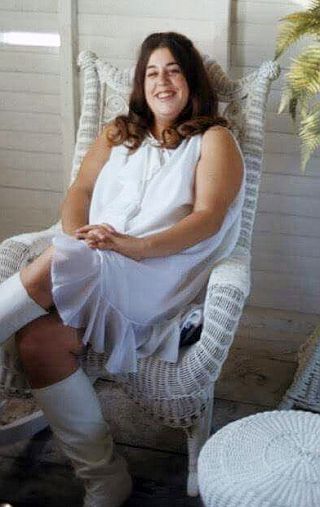
1960s. Mama Cass Elliot on her porch in Laurel Canyon.
Music Player
“I Call Your Name”-1965-66
Cass Elliot takes a strong lead on this song, and at one point, during the instrumental break in the song, faintly whispers “John…John,” signaling her crush on John Lennon. Cass also has something of a Barbra Streisand-type moment on one note during the song. And call-backs and strong background harmonies also come through nicely on this tune. This song also showcases the honky-tonk piano sound, a feature heard on a few other Mamas and Papas songs.
Mama Cass was born Ellen Naomi Cohen in Baltimore, Maryland and would later take the stage name Cass Elliot. She grew up mostly in the Alexandria-Virginia-Washington-D.C. area, with some high school there and in Baltimore. With an interest in acting, she moved to New York City in the early ’60s and did some touring with in a production of The Music Man and had also vied with Barbra Streisand for a role in, I Can Get For You Wholesale. Cass did not begin to sing until after attending American University in Washington, D.C., where she met Tim Rose, leader of the Big Three folk group, joining them at a time when folk music was sweeping the nation, and also recording a few albums. By 1964 the group was reconfigured and renamed the Mugwumps, with Denny Doherty, Zal Yanovsky and John Sebastian. She and Denny, at different times, later joined John and Michelle Phillips in the Mamas & Papas.

The two "Mamas": Michelle Phillips and Cass Elliot.
One of her fans online, Caroline Anderson, assembling 20 of her songs with annotation, notes in part: “…Cass is one of the most technically precise singers. … such clear diction, agile and lithe and bel canto all at once. It’s not the voice of someone who happens to sing well, it’s a Stradivarius in a world of Yamahas.”
Cass Elliot also became a notable figure in the Laurel Canyon scene, sometimes called the Earth Mother of that community. Some of her friends lauded her as a kind of “1960s Gertrude Stein” (matchmaker of American expatriate artists in Paris during the 1920s), said to have helped bring various musicians together at her Laurel Canyon home, contributing to the careers of Joni Mitchell for example, and also folk-rock supergroup, Crosby, Stills and Nash, among others.
Troubled by being overweight since she was a young girl, Cass offered an outgoing personality, engaging humor, and a quick wit (with a high IQ) to make herself well liked and well respected by her peers. Fan Caroline Anderson adds: “Cass was, by all accounts, one of the funniest women of her time. Read about it in any biographies of the time, or just watch her trade barbs with Johnny Carson, yuck it up with The Smothers Brothers, or spoof yogurt commercials on The Julie Andrews Comedy Hour….” John Sebastian adds: “Cass was a star. Whatever room she was in became her salon. She had this wonderful charisma.” Even John Phillips, who had his differences with Cass, would later pay her this compliment: “She was as good as Streisand and she was as good as Joplin. She could have done anything.”
More 1st Album
Back to their first album, the Mamas and the Papas, with Denny Doherty in the lead, also did a cover of the 1958 song, “Do You Wanna Dance.”
Music Player
“Do You Wanna Dance”-1965-66
This song was first written and performed by American R&B rocker, Bobby Freeman. At that time, the song became a No. 5 hit on the Billboard Top 100 chart and No. 2 on the R&B chart. Freeman’s version, however, was lively and upbeat rock ‘n roll. The Mamas and Papas version was slowed down, allowing for a showcasing of both Denny’s tenor and group harmonies. A Beach Boys’ cover of this song had also come out in February 1965, about a year before the Mamas and Papas album with their version. The Beach Boys song hit No. 12 on the charts. The Mamas and Papas’ version wasn’t released as a single until 1968, with “My Girl” on the B side. At that time, the song did chart, at No. 78 on Billboard and No. 43 on Cash Box.
Monday, Monday
The biggest hit for the Mamas and the Papas – also coming in 1966 from that first album – was “Monday, Monday.” This song was also written by John Phillips, who said he wrote it in about 20 minutes, and later also that he had no idea what it meant.
Music Player
“Monday, Monday”-1965-66
Denny Doherty sings the lead throughout, as the others provide the counterpoint background vocals. The song also has a false ending, which serves to showcase the blended voices on the restart. And like other songs from that album, “Monday, Monday” was backed by the instrumental talents of L.A.’s “wrecking crew” session musicians, including: Larry Knechtel on keyboards, Joe Osborn on bass, Hal Blaine on drums, and P.F. Sloan played guitar and used a tremolo effect on his part, which he overdubbed later. He described the “Monday Monday” recording work as a “magical session.”

Denny Doherty, distinguished tenor, sang lead on "Monday, Monday" & other Mamas & Papas songs.
…Oh Monday mornin’, Monday mornin’ couldn’t guarantee
That Monday evenin’ you would still be here with me
…Oh Monday mornin’ you gave me no warnin’ of what was to be
Oh Monday, Monday, how could you leave and not take me…
Released as a single in March 1966, “Monday, Monday” would become a No.1 hit on the U.S. Billboard Hot 100, the first time a male-female recording act had achieved that mark. The song hit No. 1 on May 7th, 1966 and remained in that slot for three weeks. A year later, by March 1967, the single had sold more than 3 million copies. “Monday, Monday” is a good example of symphonic California folk-rock, overlain with rich vocal harmonies.
I Saw Her Again
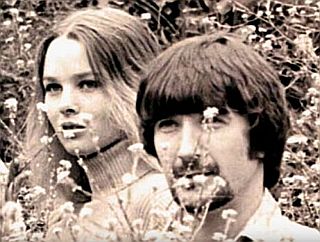 Michelle Phillips and Denny Doherty, amid the flowers. |
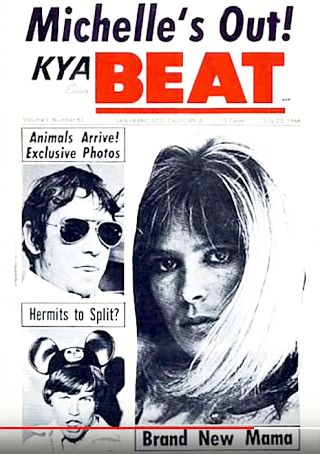 The “KYA Beat” newsletter, from KYA radio station in San Francisco, gave cover billing to Michelle’s ouster in July 1966, picturing her replacement, Jill Gibson with tagline, “Brand New Mama”. |
“I Saw Her Again,” the Mamas and the Papas third hit single, is another song written by both John Phillips and Denny Doherty, and also had as its inspiration, at least in part, Michelle’s affairs, reportedly one with Denny and another with Gene Clark of The Byrds. The Denny affair had begun earlier with Denny’s advances in the Virgin Islands, later consummated in California.
Music Player
“I Saw Her Again”-1966
But Michelle would later say of “I Saw Here Again” that she thought it mean of John to have Denny write lyrics about the affair.
As later interviewed, Michelle explained: “…That’s when I said to him, ‘John, it seems a little sadistic to me that you would make Denny write the song with you.’ And he said [in reply], ‘I, personally believe in turning tragedy into publishing’.” As Michelle’s interviewer noted on that point: “He [John] wrote a song about it and made a million dollars.”
Denny, for his part, would say the affair with Michelle was a “one-and-done” incident and was over quickly, although at the time, Denny fell pretty hard.
John, however, was so angered by Michelle’s activities that he moved to have her kicked out of the group. Cass, as well, with long-standing romantic designs on Denny, wasn’t happy with Michelle.
Michelle Out!
But Michelle’s affair with Gene Clark might have been more of a factor in John’s anger. At one point Michelle had arranged for a guest pass to be given to Clark so he could attend a Mamas and Papas concert. He showed up at the concert in the front row wearing a bright red jacket.
Denny Doherty would later describe Michelle on stage blowing kisses to Clark during the performance, which enraged John.
After the show, John chased Michelle into the parking lot telling her she was through with the group and was fired. And for a time, Michelle was removed from the group.
In fact, after consulting Dunhill and their attorney, John, Cass, and Denny formally served Michelle with a letter on June 28, 1966 expelling her from the group.
Michelle’s reaction was explosive. She crashed a recording session of the “new” Mamas and Papas and at one point even took a swing at Denny when he refused to side with her. She also screamed at the group, telling them she would “bury” them all, then stomped out.
As Michelle later recounted in Vanity Fair: “I sat in my car, shaking and despondent and crying hysterically. I had just been fired by my husband and my best friends. I thought my life was over.” And indeed, John had once told her, “I created you, and I can take it all away,” which Michelle later realized he could, endangering her then golden existence. So she fought like hell to get back in the group.
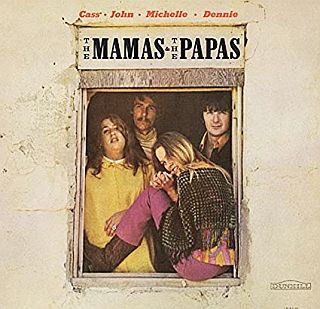
Sept 1966. Mamas & Papas’ 2nd album cover, set inside an old building window, smudges and all, also known as the “Cass, John, Michelle, Dennie” album. Click for CD.
In any case, apart from the ongoing soap opera, “I Saw Her Again,” did quite well on the charts. It was released in June 1966, and did especially well in Canada, owed in part to generous on-air playing at Chicago radio station WLS. By the week of July 30, 1966, the song peaked at No. 1 on the RPM Canadian Singles Chart, No. 5 on the Billboard Hot 100, and No. 11 on the UK Singles Chart. The song also appeared on the group’s second album, titled, The Mamas and The Papas, released in September 1966.
Dunhill producer, Lou Adler, borrowing from the Phil Spector “wall of sound” studio production method, filled up all the spaces on this song with multiple layers of voices and “wrecking crew” instrumentation. “I just overloaded it with production,” he would later say of the song, “it’s got everything on it that I could possibly think of, and just kept building and building.”
|
Mamas & Papas “California Dreamin’” |
By October 1966, the Mamas and the Papas had their fourth Top 40 hit of 1966, “Look Through My Window” reaching No. 24, followed by another Top Ten hit, “Words of Love,” released in November 1966, and peaking at No. 5 on the Billboard chart in January 1967. Both were written by John Phillips.
“Look Through My Window” was written earlier by John, in 1964, when he was separated from Michelle, with emotional lyrics, which according to one AllMusic review, “are mirrored perfectly, with a melancholy chord progression and simple, intertwining melodic lines.” Suggested as “near classical in its approach,” the song is regarded by some as one the group’s best. However, on the charts, “Words of Love” would do better.
Music Player
“Words of Love”-1966
“Words of Love” features Cass Elliot throughout, and she doesn’t disappoint. The song, written by John Phillips, has a jaunty bounce to it musically, filled with honky-tonk piano as Cass dispenses her advice to guys looking to win the affections of their ladies:
Words of love, so soft and tender
Won’t win a girl’s heart anymore.
If you love her, then you must send her
Somewhere where she’s never been before.
Worn out phrases and longing gazes
Won’t get you where you want to go. (No!)
Words of love, soft and tender
Won’t win her…
During 1966, the group was doing some touring, but by some accounts, they didn’t always have their act together as a polished performance.
At a September 1966 concert at Fordham University in New York City, the band appeared out of sorts, and was reported as “high, drunk, or tripping,” and shouldn’t have been on stage according to other musicians with them at the time.
But later on the tour, it appeared they did pull themselves together. At New York city’s Carnegie Hall on November 11th, 1966, one short review of their performance was filed by Robert Shelton of the New York Times, noted:
…[T]he Mamas and the Papas displayed some of the most elegant vocalizing, compelling arrangements and goosepimple-producing harmonies to be heard in pop music these days…[They] are giving luster and depth to the musical qualities of rock ‘n roll.
The Mamas and The Papas by mid-1966 – only seven months or so after their arrival in Los Angeles – had risen to the top of pop music and the L.A. social scene with dizzying speed. They had hit the big time. One day they were poor and barely surviving, next day they were incredibly rich. “It was like winning the lottery,” Michelle would later say. Once famous, and performing on weekend tours, they could pull in the equivalent of $250,000-to-$300,000 in today’s money. And they each spent freely – on homes, sports cars, parties, drugs. John and Michelle bought Jaguars; Cass had a Porsche 911; and Denny a Lincoln Continental convertible. The money wasn’t an end in itself, they would say, but it became like a “salve,” as Denny would later describe it, to cover over their interpersonal affairs and group travail. Yet, still, at least for a time, they managed to stay together for the music.
1967
More Hits

1967. “The Mamas & The Papas Deliver,” their third studio album rose to No. 2 on Billboard, and included top hits, “Dedicated to the One I Love” and “Creeque Alley.” Click for album or singles.
Music Player
“Dedicated to the One I Love”
In March, one of the singles from the album – “Dedicated to the One I Love” – a song first written for the Five Royals in 1957, also a big hit for The Shirelles in 1961 – became a No. 2 hit for the Mamas and Papas in 1967, both in the U.S. and the U.K.
The lead singer on this Mamas & the Papas tune was Michelle Phillips. It was the first time Michelle was given the lead over Cass Elliot. The song also has some prominent piano support. “Dedicated to the One I Love” was included on the group’s 1967 album, The Mamas & The Papas Deliver. The song also had Top Ten ranking in Australia, Belgium, Ireland, New Zealand, and South Africa.
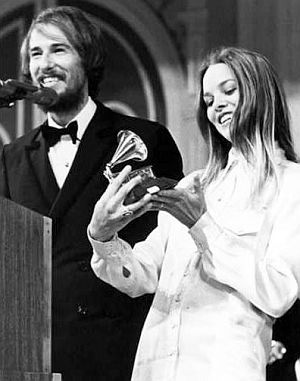
March 1967. John and Michelle Phillips accepting Grammy Award for 1966 Mamas & Papas hit song, "Monday, Monday".
Another hit single for the Mamas & Papas in 1967 came with “Creeque Alley,” the group’s autobiographical song about how they formed in their early years. It’s an insider’s account, written by John and Michelle Phillips, telling of their time in the Virgin Islands where they sang at a club on “Creque” or “Crequi” alley, and also naming the folks who played a role in their music industry travels — or as one New York Times reviewer noted, “names of people and places that made sense only to about 50 people in the country…”. Nevertheless, the song peaked at No. 5 on the U.S. Billboard pop singles chart the week of Memorial Day 1967. It also hit No. 9 on the U.K. charts and No. 4 in Australia and Canada.
On June 11, 1967, the group appeared on The Ed Sullivan Show at CBS studios in New York, where they performed both “Creeque Alley” and “Dedicated To The One I Love”. It was their second appearance on the Sullivan show – in those days, a sought-after Sunday night TV venue and quite a big deal. But the big event of the summer of 1967 — in which John Phillips in particular, would play a major role — was about to unfold in Monterey, California.
Success & Strife
By the time of the Monterey Pop Festival, the Mamas and Papas were living the good life, reaping the rewards of their musical success. In two years time – 1966-67 – the disparate group of musicians had become wealthy superstars. During those two years they had six singles that were Top Five hits plus four gold albums. John and Michelle had bought a mansion in Bel Air, described in the Los Angeles Times as “a baronial old Norman country house” formerly owned by 1930s actress Jeanette MacDonald. It was here where they hosted parties attended by rock royalty and Hollywood glitterati, including members of The Rolling Stones and The Beatles. As noted earlier, Cass Eliott had a home in Laurel Canyon – formerly owned by actress Natalie Wood. Denny Doherty as well, had a large hilltop home — a two story Spanish house in the hills off Sunset Plaza once owned by Mary Astor.
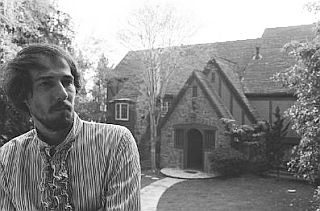
1960s. John Phillips in front of the home in Bel Air that he and Michelle shared, and where John would install a recording studio.
Although John had installed a full recording studio in the mansion where he and Michelle lived at a cost of $100,000, there was less and less of the group coming together to record, as vocal parts and music were pieced together separately. Work on their fourth studio album – the album that would later become The Papas and The Mamas – was slow and halting, and wouldn’t be complete for months. Still, in August 1967 the group did rally for a concert performance before 18,000 fans at the Hollywood Bowl with Jimi Hendrix as the opener. John and Michelle Phillips would recall the concert as one of their top career moments.
However, due to the slow progress on their fourth studio album, Lou Adler at Dunhill Records, hoping to keep the group in the public eye, decided to release a “greatest hits” album, entitled, Farewell to the First Golden Era. Also at that time, around August 1967, a single, “Twelve Thirty (Young Girls Are Coming to the Canyon),” one of the completed songs intended for the delayed fourth studio album, was released and included on the greatest hits album. Both album and single did well. The song peaked at No. 20 in the US and the album did even better, hitting No. 5 and receiving U.S. “gold” status.
Music Player
“Twelve-Thirty”
“Twelve Thirty,” written by John Phillips, was inspired by Laurel Canyon. The narrator begins by saying he formerly lived in “dark and dirty” New York city, where a broken clock on a church steeple was stuck at 12:30. The song’s lyrics then move on to “the Canyon,” generally assumed to mean the Laurel Canyon where Phillips and band spent time at Cass’s home and elsewhere.
One interpretation of the Phillips’ lyric, “young girls are coming to the canyon,” etc, has it that girl “groupies” would party late into the night at various VIP canyon homes, walking home the next morning in view of the narrator as they went by.
In any case, the song captures the Mamas & Papas good harmony in their performance, making it one of their memorable hits. “Twelve Thirty” would also appear later on the group’s fourth studio album, The Papas and The Mamas. The group would perform the song on The Ed Sullivan Show on September 24th, 1967, in one of their last televised appearances as a group. In October 1967, the non-album single “Glad to Be Unhappy,” reached No. 26 in the U.S. “Dancing Bear,” from the group’s earlier second album was released as a single in November. It peaked at No. 51 in the U.S.
Meanwhile, fissures in the group had grown. A trip abroad to Europe was begun, billed by John as time off and an attempt to rejuvenate their music. There were also some scheduled performances in London along the way, but Cass was arrested there on some odd charges, and the shows were cancelled. Cass and John also had a falling out on that trip, and at one point while travelling, Cass announced the group was finished. Back in the states, Cass and John did reconcile and the group managed to finish their fourth studio album. The Papas & The Mamas, released in May 1968. But things were never quite the same again.
After the second single from that album, “Safe in My Garden,” released in May 1968, made it only to No. 53, Dunhill then released Cass Elliot’s solo from the album, “Dream a Little Dream of Me.” John opposed that release, but the song hit No. 12 on the U.S. charts and No. 11 in the U.K. It signaled the beginning of Mama Cass’s solo career.
Music Player
“Dream a Little Dream of Me”
The fourth and final single from The Papas & The Mamas, “For the Love of Ivy” in July 1968, peaked at No. 81 in the U.S. That was followed in October 1968 by Dunhill digging out and releasing “Do You Wanna Dance” from the group’s first album, reaching No. 76 in the U.S.
Dunhill also milked the Mamas & Papas back list for three more compilation albums: Golden Era Vol. 2 in 1968, 16 of Their Greatest Hits in 1969, and Monterey Live album in 1970.
But for all intents and purposes, the Mamas and the Papas were finished by 1968. They struggled to deliver their final work to Dunhill (after litigation from both sides) with a fifth studio album completed, but not until 1971, People Like Us. Each of group’s members by then had gone their separate ways: John, Cass, and Denny with solo albums either released or in the works, and Michelle pursuing an acting career.
Cass Elliot, for one, began to have considerable career success – turning out a series of albums – two for Dunhill and three for RCA, also touring in the U.S. and Europe. She became a favorite on TV – both on music variety shows and the late night talk-show circuit. She starred in two TV specials: The Mama Cass Television Program on ABC in January 1969 and Don’t Call Me Mama Anymore on CBS in September 1973. However, it was a real shock when Cass died while on tour in England. She died of heart failure in London on July 29, 1974, after completing a two-week engagement at the Palladium. She was 32 years old. Her Palladium shows had been mostly sold out, where her performances brought standing ovations. Lou Adler, who attended Cass’s Palladium opening, along with George Harrison, Ringo Starr and other ‘70s pop stars, would later note: ”She was really up. She felt she was opening a new career; she’d finally got together an act she felt good doing, not prostituting herself… and she enjoyed doing it.”
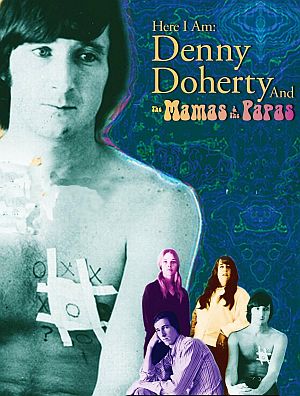 Cover for 2009 documentary, “Here I Am: Denny Doherty and the Mamas and the Papas”. |
Michelle and John were divorced in 1969, though he and Michelle had a daughter, Chynna, born in February 1968. Michelle had relative success as an actress, with notable roles in Dillinger (1973) and Valentino (1977). She also produced a solo album, Victim of Romance in 1977. In addition to her film career, Michelle was also still reaping rewards from her Mamas and Papas years. As she reported in December 1985: “I still make fine royalties from the albums. If you had told me in 1968 that 20 years later I’d still be receiving wonderful royalty checks for those three years [1966-68], I wouldn’t have believed you.” Michelle would continue to land film roles through the 1990s and would also find acting success on TV’s Knots Landing series and other shows. She also had a series of romances with Hollywood actors, among them: Dennis Hopper (to whom she was married for 8 days in 1970), Jack Nicholson, and Warren Beatty.
John Phillips released his solo album John, The Wolf King of L.A. in 1970. He would also become involved in a variety of other projects, including one with Andy Warhol, and later with the Rolling Stones. In the 1970s, he wrote songs for film soundtracks, including: Brewster McCloud and Myra Breckinridge in 1970 and The Man Who Fell to Earth in 1976. In 1974 he wrote most of the tracks for Romance Is on the Rise, an album by his third wife, Geneviève Waïte, which he also produced.
However, by the mid-1970s, according to Rolling Stone, Phillips “had become idle….reportedly living off his $100,000-a-year royalties from songs like ‘California Dreamin`’ By 1975 he had quit work altogether.” John also succumbed to drug use of one kind or another, which would haunt him throughout his life. Still, there would be flashes of his creative talents.
In 1988, he co-wrote “Kokomo” for The Beach Boys, a No. 1 hit. And in the early 1980s, after serving jail time for a narcotics violation, he reconvened a “new Mamas & Papas” group, consisting initially of himself, his daughter Mackenzie, Spanky McFarlane of Spanky and Our Gang taking the Cass Elliot part, and a returning Denny Doherty. The “new Mamas and Papas” performed steadily for a time and received some favorable notices, but there were no albums and personnel changes persisted.
Denny Doherty, meanwhile, had returned to Nova Scotia, and in addition to two solo albums, did some stage acting, hosted a TV variety show, Denny’s Sho, for one season, and also did a longer-running children’s TV program. In 1997, Doherty co-wrote and performed in the autobiographical stage musical, Dream a Little Dream (the Nearly True Story of the Mamas and the Papas), which debuted in Canada and also ran off-Broadway in 2003. Doherty, a recovered alcoholic, died of an abdominal aortic aneurysm in January 2007. A 2009 documentary by Paul Ledoux, Here I Am: Denny Doherty and the Mamas and the Papas, premiered in Halifax and later ran on the Bravo cable TV network.
Among the more tragic life courses of Mamas and Papas members was that of John Phillips, whose considerable musical talents would be squandered by drug abuse. Periodically he cleaned up, but never really broke free of addiction’s pull, with a $1,000-a-day heroin habit in later years that would nearly kill him. He later recounted depleting his wealth and possessions to support his habit. “I had 12 Rolls Royces and a good art collection, and I slowly wasted all of it,” he said in one interview. In 1992, his years of drinking and drug abuse resulted in a liver transplant. In 1995, he married his fourth wife, Farnaz Arassteh, an artist, spending his last years with her in Palm Springs, California. On March 18, 2001, John Phillips died of heart failure in Los Angeles at the age of 65. A posthumous album, Phillips 66, was released a few months after his death.
Michelle Phillips kept at her acting craft through the early 2000s, and had an 18-year relationship with her partner, Steve Zax, until his passing in 2017. As the last surviving member of the Mamas and the Papas, she has become its spokesperson and caretaker, appearing most recently in Echo in the Canyon, a 2019 documentary on the 1960s Laurel Canyon music scene. She also became something of a helper to various Mamas and Papas progeny over the years, had another child of her own, and also adopted a third child – all three now grown.
For The Record
Several books on the adventures of the Mamas and the Papas have been written, not least of which are two that might be described as “dueling memoirs” – one each from John and Michelle Phillips, both published in 1986. Michelle has reported that initially, she had cleared her book with the other members of the Mamas & Papas, including John, only to be surprised to learn somewhat later that John, too, had landed a book deal.
John’s book – Papa John: An Autobiography (of the Mamas and the Papas): A Music Legend’s Shattering Journey Though Sex, Drugs, and Rock ‘n’ Roll (Doubleday, 444 pp.) — came out in early 1986. It recounts his life and career from childhood to stardom, and as the subtitle suggests, his extracurricular activities as well. The blurry “Papa John” title on the hardback signaled some of what would follow.
Michelle’s book is a somewhat softer treatment, titled, California Dreamin’: The True Story of the Mamas and the Papas – The Music, the Madness, the Magic That Was (Warner Books, 190pp). In the book, Michelle also tells her life story, particularly the years with John and The Mamas and the Papas up through 1968. Publisher’s Weekly found her book to be “a sanitized account compared to John’s,” but hers is “more successful at putting events into historical context.” Michelle’s portraits of the group and its members were called engaging by some critics, while others found her a little trite with the use of `60s-period phrasing. But some readers enjoyed Michelle’s description of “what it was like to have lived during the late 60’s – Flower Power, the hippie scene and the ‘Summer of Love’”– a stated intent by Michelle in writing the book.
John’s book, on the other hand, is the more unvarnished treatment. As reviewer Paul G. Feehan for Library Journal notes: “John names names, filling in the raunchy details that Michelle only sketches… His book is a hard and honest account whose glamour is tempered with grimness.” But some critics found John’s account to be overly self-indulgent and hedonistic, with repetitive details of his sexual exploits and drug use. One Chicago Tribune reviewer, considering both books together, noted that on stage it was “California Dreamin’,” but off stage “it was more like screamin` than dreamin`,” with assorted debaucheries for what would later be called, “life in the fast lane.” Both John and Michelle also did respective book tours, including the TV talk-show circuit, with some of those still found on YouTube.com.
Added to John and Michelle’s accounts are three other books and a couple film documentaries. Among these is Doug Hall’s book, The Mamas and the Papas: California Dreamin’, published in July 2000 as a 240-page Quarry Press paperback. Another is Matthew Greenwald’s 2002 book, Go Where You Wanna Go: The Oral History of the Mamas and the Papas (Cooper Square Press, 328 pp).
Greenwald’s book includes interviews with Michelle and Denny; material from an unpublished Cass Elliot interview; and comment from Lou Adler, Roger McGuinn, David Crosby, Graham Nash and some “wrecking crew“ musicians. Joel Selvin, Pop Music Critic for the San Francisco Chronicle calls the book “the definitive account of this American rock fable.”
Michael Fremer of Listener magazine adds: “Much more than merely a history of The Mamas and The Papas, Greenwald’s book is a snapshot of a magical time in our cultural history. The interconnections it delineates are absolutely fascinating.”
A profile of Cass Elliot is found in Eddi Fiegel’s 2005 book, Dream a Little Dream of Me: The Life of Cass Elliot (Chicago Review Press, 416 pp). An Amazon.com summary explains:
…[T]his book follows her development from her misfit teenage years to her part in the folk boom of the early 1960s. How Cass came to join the Mamas and the Papas, and the mix of love, hurt, and betrayal that fractured relationships within the group is central to the story as Cass is driven to strike out on a successful solo career. This account reveals the considerable unhappiness Cass experienced that was hidden by her jovial facade—her unrequited love for Papa Denny Doherty, her unhappy marriages and affairs, and her tragic death at age 32.
Publisher’s Weekly adds that the book’s author, Eddi Fiegel, “has done her homework; she speaks with seemingly everybody who knew Elliot and examines nearly every step of her personal life and career, from her displaced childhood to her years as a star musician…”
In addition to the books, there are also a few DVDs on The Mamas and The Papas. Among these is the 2005 PBS television documentary, California Dreamin’: The Songs of the Mamas and the Papas. There is also a DVD for the 1988 documentary, Mamas & The Papas: Straight Shooter (130 minutes, 2008 release). And online, there are a few YouTube offerings of past TV specials, such as VH-1 “Behind The Music” features and past interviews and talk-show appearances by one or more of the group.

The Mamas & The Papas performing, 1960s.
The Mamas and The Papas had their incandescent moment in the progression of popular music — and an important and memorable moment it was! Their talents burned bright for a few short years as they helped advance the folk-rock genre with their beautiful harmonies, showcasing the power of voice in creative arrangement. Their exceptional sound was unique and is enduring to this day. They turned out modern-day madrigals, a kind of easy-listening chamber rock that fit the times and caught the ear of millions. They weren’t alone, of course, as a number of groups were also at that founding – the Byrds, Buffalo Springfield, the Beach Boys, and Simon & Garfunkel, to name a few. Still, they notched a fair claim in the annals of folk-rock music during 1966 and 1967 with their exceptional songs; too bad there wasn’t a bit more of it. Their time was much too short.
For additional stories at this website on the music of the 1960s and 1970s, see for example: “Crosby, Stills & Nash, 1969 & Beyond,” a profile of the group formed by David Crosby, Stephen Stills and Graham Nash (later joined by Neil Young); “Joni’s Music, 1962-2000s”, a profile of Joni Mitchell’s amazing career; and, “Early Beach Boys, 1962-1966,” focusing on their early hits and the role of Brian Wilson as songwriter and producer. Additional stories on music can be found at the “Annals of Music” category page.
Thanks for visiting – and if you like what find here, please make a donation to help support the research and writing at this website. Thank you. – Jack Doyle
|
Please Support Thank You |
____________________________________
Date Posted: 15 August 2020
Last Update: 15 August 2020
Comments to: jdoyle@pophistorydig.com
Article Citation:
Jack Doyle, “The California Sound – Mamas & Papas:
1965-1968,” PopHistoryDig.com, August 15, 2020.
____________________________________
Sources, Links & Additional Information
“The Mamas and the Papas,” in Holly George-Warren and Patricia Romanowski (eds), The Rolling Stone Encyclopedia of Rock & Roll, Rolling Stone Press, New York, 3rd Edition, 2001, pp. 600-601.
Paul Evans, “Performers: The Mamas And The Papas,” RockHall.com, 1998.
“The Mamas and the Papas,” Wikipedia.org.
John Phillips, Papa John: An Autobiography (of the Mamas and the Papas): A Music Legend’s Shattering Journey Though Sex, Drugs, and Rock ‘n’ Roll, 1986, Doubleday, 444pp.
Michelle Phillips, California Dreamin’: The True Story of the Mamas and the Papas – The Music, the Madness, the Magic That Was, 1986, Warner Books, 190pp.
“Cass Elliot,” Wikipedia.org.
“The Mamas & The Papas Discography,” Wikipedia.org.
Tom Moon, “California Dreamin`: The Mamas and the Papas,” 1,000 Recordings to Hear Before You Die, New York: Workman Publishing, pp 171–172.
“California Dreamin`,” Wikipedia.org.
“If You Can Believe Your Eyes and Ears” [first album], Wikipedia.org.
Carol Deck, Cover Story, “A Tale of Mama’s and Papa’s,” The Beat (KRLA radio station, Los Angeles, CA), April 30, 1966, pp. 4-5.
“Michelle Phillips,” Wikipedia.org.
“A Break-Up For the Mamas and The Papas?,” The Beat (KRLA), July 9, 1966, p. 2.
Robert Shelton, “Mamas and Papas at Carnegie Hall,” New York Times, November 12, 1966, p. R-23.
“Monterey Pop Festival,” Wikipedia.org.
Website, MontereyInternationalPopFestival.com.
Lynn Lilliston, “Mamas and Papas Dig The Homeowner Scene,” Los Angeles Times, August 16, 1967, p. 61.
“Go Where You Wanna Go,” Wikipedia.org.
“Festivals: Soulin’ at Monterey,” Time, Friday, June 30, 1967.
Jan Sears, “Mamas and Papas Win Bowl Crowd,” The San Bernardino County Sun,(San Bernardino, CA), August 22, 1967, p. 9.
Cover Story Tagline: “Mamas and Papas Leave Pop For ‘Adventure’,” Inside Story: “Mamas, Papas Quit Pop,” The Beat (KRLA, Los Angeles, CA), October 21, 1967, pp. 1, 4.
Tom Phillips, “Rock Speaks Sweetly Now,” New York Times, December 17, 1967, p. 130.
“Touring With The Mamas and The Papas” (cover tagline), story by William Kloman, “The “Mamas and the Papas: ‘Just Call Us Super Group’,” The Saturday Evening Post, March 25, 1967, pp. 36-41.
Robert Christgau, “Anatomy of a Love Festival” [Monterey Pop], Esquire, January 1968.
William Kloman, “Has Success Spoiled Supergroup?,” New York Times, Sunday, July 14, 1968, p. 22-D.
“Twelve Thirty (Young Girls Are Coming to the Canyon),” Wikipedia.org.
Ben Fong-Torres. “John: ‘It Sounded Like the Mamas and the Papas’; A Band Gets Back Together,” Rolling Stone, June 10, 1971.
‘Mama Cass’ Elliot Dead; Remembering the Mamas and Papa’s singer,” Rolling Stone, August 29, 1974.
“Creeque Alley,” Wikipedia.org.
John M. Wilson, “One of the Mamas Is Making Book on the Mamas and Papas,” Los Angles Times, November 3, 1985.
Marilyn Beck, “Michelle Phillips Reveals What She Left out of Book,” Sun-Sentinel (South Florida), December 21, 1985.
Book Review, “California Dreamin’: The True Story of the Mamas and the Papas,” by Michelle Phillips,” Kirkus Reviews, April 15, 1986.
Book Review (of both Papa John and California Dreamin), “California Screamin` From a Mama and a Papa,” Chicago Tribune.com, May 18, 1986.
Michelle Phillips, Guest (book interview, California Dreamin), Regis Philbin, Lifestyles (TV show), YouTube.com, 1986.
Stephen Holden, “Pop: Mamas and the Papas,” New York Times, November. 5, 1987.
Michael Ollove, “1960s Siren Baltimore’s Cass Elliot Spoke to a Generation with Her Music, and Now Her Voice Is Being Heard Again,” BaltimoreSun.com, May 4, 1997.
Andrew G Marshall, “No One’s Getting Fat Except Mama Cass. So Sang the Mamas & the Papas in One of the Hits That Shot Them to Stardom in the 60s. But When Cass Elliot Died, 25 Years Ago This Week, Did All Hope of a Larger-Than-Life Role Model in Pop Die With Her?,” TheGurardian.com, July 25, 1999.
Neil Strauss, “John Phillips, 65, A ‘Papa’ of the 1960’s Group, Dies,” New York Times, March 19, 2001.
“John Phillips – Papa John from The Mamas & The Papas,” HollywoodMemoir.com, March 18, 2001.
Tim Page, “The ’60s Melody Man” [re: John Phillips], WashingtonPost.com, March 20, 2001.
“John Phillips (musician),” Wikipedia.org.
Sheila Weller, “California Dreamgirl,” Vanity Fair.com, November 20, 2007 (December issue).
Geoff Boucher, “‘California Dreamin`,’ The Mamas & The Papas, 1965,” Los Angeles Times, June 8, 2008.
“Songs That Shaped Rock and Roll: “California Dreamin’,” RockHall.com, September 19, 2016.
Matthew Greenwald, Go Where You Wanna Go: The Oral History of The Mamas and The Papas, 2002, Cooper Square Press, 328 pp.
James McNair, “Michelle Phillips: Trip of a Lifetime,” Independent.co.uk, October 30, 2004.
Eddi Fiegel, Dream a Little Dream of Me: The Life of Cass Elliot, 2005, Chicago Review Press, 416 pp.
Associated Press, “‘Mamas And The Papas’ Doherty Dies At 66,” Billboard.com, January 19, 2007.
International Herald Tribune, “Denny Doherty, 66, of The Mamas and the Papas, ’60s Singing Group, Dies,” New York Times, January 21, 2007.
Frazier Moore, “Phillips Defends Incest Memoir, Says it Can Help Others,” SeattleTimes.com, September 24, 2009.
JohnF, “A Dark & Haunted Album From the Masters of Sunshine Pop,” Amazon.com, review of album, The Mamas and The Papas, October 19, 2013.
“Flower Children: The Mamas and Papas Story (Australian play),” 2011-2013, Magnor-mos.com.
“Music: John Phillips: ‘Papa John’s Blues’,” AndrewDarlington.Blogspot.com, May 27, 2014.
“I Saw Her Again,” The Mamas and The Papas,” Canadian Songwriter’s Hall of Fame / CSHF.ca, Year Inducted: 2017.
William McKeen, Everybody Had an Ocean: Music and Mayhem in 1960s, 2017, Los Angeles Chicago Review Press, 288 pp.
Caroline Anderson, “20 Cass Elliot Solo Songs You Should Know,” Medium.com, January 25, 2018.
Tom Breihan, “The Number Ones: The Mamas And The Papas’ ‘Monday, Monday’,” Stereo Gum.com, September 5, 2018.
Charles Donavan, “Harmony & Me”(Michelle Phillips interview), RnR Magazine, November /December 2018 (Vol 2, Issue 72).
Keith Chaffee, Librarian, “Music Memories: John Phillips,” Los Angeles Public Library / lapl.org, August 30, 2019.
JJ Foster, “Behind-the-Scenes Secrets About The Mamas & The Papas,” PensAndPatron .com, October 15, 2019.
Jacqueline Tager, “Luminaries of the Canyon: Laurel Canyon’s Most Star-Studded Home,” TheHollywoodHome.com, November 30th, 2019.
VH-1, “The Mamas and the Papas: Behind the Music,” YouTube.com, posted, Posted by Karen Fuentes, May 30, 2020.
“The Mamas and The Papas,” Biography (1989) / YouTube.com, Posted by Karen Fuentes, May 15, 2020.
“Fabulous Flip Sides – Cass Elliot,” Goldmine Mag.com, July 17, 2019.
Patrick Ryan, “’Laurel Canyon’: Mamas and the Papas Singer on the ‘Very Big Highs and Lows’ of ’60s Music Scene,” USAtoday.com, May 29, 2020.
“Michelle Phillips: Life in The Mamas and the Papas,” RocksOffMag.com, March 24, 2020.
___________________________________
